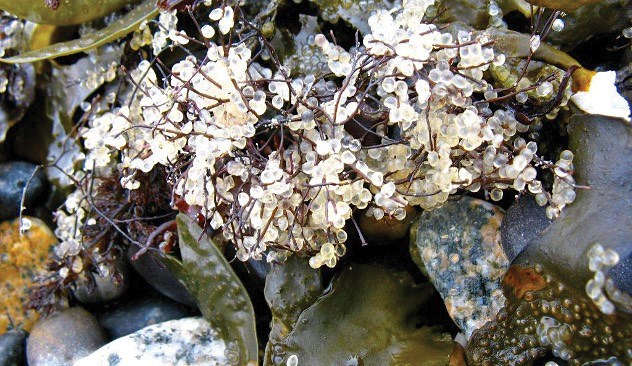The Sunshine Coast Friends of Forage Fish volunteer group would like to remind the public –especially all those gardeners – that herring spawn season is upon us, and herring are one of the many important forage fish species.
What are forage fish, you ask? Forage fish are abundant, schooling fishes, and include herring, anchovies, smelt, sand lance, and many more. They are an essential component of marine ecosystems, providing critical food sources for many birds and for larger fish such as salmon and ling cod, which in turn are eaten by marine mammals such as sea lions and orcas.
Surf smelt and sand lance use the intertidal zone of the beach to spawn during high tides. Herring are pelagic spawners, (in the water column) but come close to the shore looking for places to lay their eggs on wood, rocks, or seaweeds, causing a feeding frenzy amongst the seals, sea lions, otters, gulls, diving ducks, and other shore birds. These seaweeds sometimes form great piles in the high tide zone of the beach and are favoured by people for mulch for their gardens.
As a practice, mulching is great, but when one chooses seaweed as mulch, a series of thoughtful decisions should be made beforehand.
First, what is the time of year? February, March, and April are herring spawning months on the Coast and herring will often choose seaweeds as the “anchor” for their eggs. Even when the egg-laden seaweed gets broken off and washed up on the beach, those eggs can quite happily survive until the next high tide. By taking seaweeds during the spawning season, there is the potential to destroy thousands of herring eggs. None should be collected at this time.
How much will I take, and how often? There are a lot of us in the world now, including the Sunshine Coast, and our cumulative impact is significant. That seaweed line is home to many small sea creatures and provides shelter, shade, and moisture between the tidal periods. Do you really need seaweed for mulch?
Is there something with less impact that I can use to mulch? Many of us throw out great mulch materials like grass clippings, leaves, or sawdust, even those feathers from that old quilt.
Why not use them?
If you must collect seaweed as mulch for your garden, take only small amounts, and over a large area to minimize the impact on this special area of our world, and not during the months of February, March and April. Always take a quick look to ensure there are no eggs attached to your mulch collection.
The Sunshine Coast Friends of Forage Fish is a local volunteer group that has been diligently sampling Sunshine Coast beaches for the presence of forage fish eggs. We have had findings of sand lance and surf smelt eggs at several of our local beaches.
For more information or to volunteer, contact Dianne Sanford, coordinator, Sunshine Coast Friends of Forage Fish, at [email protected]. For more information about our group, visit www.friendsofforagefish.com.



